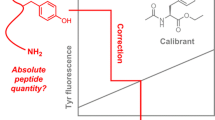Abstract
Fluorescence emission has been investigated in the context of estimation of proteins at nanogram levels. A Schiff base ligand with donor–acceptor substituents has been utilized as a fluorescent probe. The potency of this ligand is that it possesses the binding sites for both hydrophobic as well as hydrophilic groups in the proteins. The fluorescence emission of the probe was enhanced in the presence of nanogram levels of protein, which clearly signifies that even the least concentration of the protein is sufficient to perturb the environment around the probe. We demonstrate here that the fluorescence characteristic of the probe can be utilized to estimate even nanogram levels (66 ng–1 μg mL–1) of protein. The major limitation of the currently available standard methods is the range of protein estimation, which terminates at microgram level and the interference due to the specificity of the amino acids, which vary from proteins to proteins. This fluorescence emission-based method is free from interference from any type of buffers, ionic strength of the medium and any specific amino acid residue and is a simple, rapid, single-step, sensitive method of estimation which can be applied to different classes of proteins.




Similar content being viewed by others
References
Bar-Or D, Lau E, Winkler JV (2000) J Emerg Med 19:311
Gill SC, von Hippel PH (1989) Anal Biochem 182:319
Lowry OH, Rosebrough NJ, Farr AL, Randall RJ (1951) J Biol Chem 193:265
Muller HW, Frey B, Schweizer B (1992) In: Techniques for flow injection analysis in UV–Vis Spectroscopy (Publication B0507757). Perkin–Elmer, Uberlingen, FRG
Pierce (1991) In: BCA protein assay reagent: Instructions, Publication 23225. Pierce, Rockford, IL, USA
Bradford MM (1976) Anal Biochem 72:248
Waheed AA, Rao KS, Gupta PD (2000) Anal Biochem 287:73
Kumar CV, Buranaprapuk A (1999) J Am Chem Soc 121:4262
Feichtinge D, Plattner AD (2000) J Chem Soc Perkin Trans 2:1023
Shrivastava HY, Kanthimathi M, Nair BU (1999) Biochem Biophys Res Commun 265:311
Lacroix PG, Dibella S, Ledoux I (1996) J Am Chem Soc 8:541
Acknowledgements
One of the authors, H.Y.S., thanks CSIR for providing a fellowship to carry out the research work.
Author information
Authors and Affiliations
Corresponding author
Rights and permissions
About this article
Cite this article
Shrivastava, H.Y., Nair, B.U. A fluorescence-based assay for nanogram quantification of proteins using a protein binding ligand. Anal Bioanal Chem 375, 169–174 (2003). https://doi.org/10.1007/s00216-002-1673-4
Received:
Revised:
Accepted:
Published:
Issue Date:
DOI: https://doi.org/10.1007/s00216-002-1673-4




